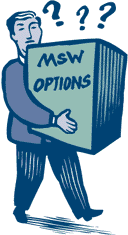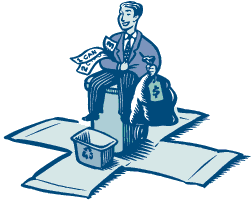MSW Planners
More Fact Sheets
Introduction | What is pay-as-you-throw? | What are the benefits of pay-as-you-throw? | Are there disadvantages to pay-as-you-throw? | How can I learn more about pay-as-you-throw?
Fact Sheet
EPA530-F-96-030
April 1997
Introduction
MSW programs today
need to offer more than reliable waste collection services. In some communities,
the issue is rising collection and disposal costs. Other communities are
looking for ways to extend landfill capacity. 
As an MSW planner, you know how important it is to reduce the amount of
waste residents put out for collection (or bring to the landfill).
In fact, your community probably started a recycling program to help divert some of this waste from disposal. Even with a strong recycling program, however, it's likely that your residents are steadily throwing away more each year-pointing to the need not only for more recycling, but also for getting residents to generate less waste in the first place.
For MSW planners in nearly 2,000 communities, a program called "pay-as-you-throw" (PAYT) is helping them meet this challenge.
What is pay-as-you-throw?
PAYT programs, also known as unit-based pricing or variable-rate pricing, provide a direct economic incentive for your residents to reduce the amount of waste they generate. Under PAYT, households are charged for waste collection based on the amount of waste they throw away-in the same way that they are charged for electricity, gas, and other utilities. As a result, residents are motivated not only to increase the amount they recycle, but also to think about ways to generate less waste in the first place.
PAYT can be structured in
several different ways. Some communities charge residents based on the
volume of waste they generate. Under volume-based programs, residents
are charged a fee for each bag or can they fill up. Communities also can
require that residents purchase tags or stickers and affix them to their
own containers. Other communities bill residents based on the weight of
their trash-although, because of the cost of the equipment needed to weigh
the waste and record the amount for billing purposes, weight-based programs
are far less common.
What are the benefits of pay-as-you-throw?
However it is structured, PAYT has the potential to improve MSW programs in several important ways. First, there are significant economic benefits. Because of the incentive to generate less, communities with programs in
place have reported reductions in waste amounts ranging from 25 to 35 percent,
on average. For many communities, this can lead to lower disposal costs,
savings in waste transportation expenses, and other cost savings. Communities
with PAYT also typically report significant increases in recycling. In some
cases, this can yield increased revenues from the sale of collected materials.
In addition, these programs can be designed to cover the cost of not only
waste collection and disposal, but also some or all of the community's complementary
MSW programs (such as recycling, composting, and bulky waste collections).
Of course, there often are new costs for the community with this system,
including expenditures for education and enforcement. These costs usually
are not significant, however-and they can be built into the program's rate
structure to ensure that they will be covered.
Because of the incentive to generate less, communities with programs in
place have reported reductions in waste amounts ranging from 25 to 35 percent,
on average. For many communities, this can lead to lower disposal costs,
savings in waste transportation expenses, and other cost savings. Communities
with PAYT also typically report significant increases in recycling. In some
cases, this can yield increased revenues from the sale of collected materials.
In addition, these programs can be designed to cover the cost of not only
waste collection and disposal, but also some or all of the community's complementary
MSW programs (such as recycling, composting, and bulky waste collections).
Of course, there often are new costs for the community with this system,
including expenditures for education and enforcement. These costs usually
are not significant, however-and they can be built into the program's rate
structure to ensure that they will be covered.
Another advantage of PAYT is the greater control over costs it offers to residents. While they may not realize it, your residents pay for waste management services. And whether they pay through their taxes or with a flat fee, those residents who generate less and recycle more are paying for neighbors who generate two or even three times as much waste. With PAYT, residents that reduce and recycle are rewarded with a lower trash bill.
This incentive to put less waste at the curb also can make a big environmental difference. When people generate less waste and recycle more, fewer natural resources are used, there is less pollution from manufacturing, and less landfill space is consumed-reducing the need to site new facilities.
Are there disadvantages to pay-as-you-throw?
While there are potential barriers to a successful program, communities with PAYT report that they have found effective solutions. Community officials often raise the prospect of illegal dumping when they first learn about these programs. Most PAYT communities, however, have found that illegal dumping in fact did not increase after implementation. This is especially true when communities offer their residents recycling, composting for yard trimmings, and other programs that allow individuals to reduce waste legally. Others, particularly lower-income residents, worry about the amount they will have to pay. In many communities, however, coupon or voucher programs are being used to help reduce trash collection costs for these households.
How can I learn more about pay-as-you-throw?
EPA has developed a series of products for anyone interested in PAYT. Individuals looking for more information on these programs can request additional fact sheets, community success stories, and other materials. For local solid waste planners interested in bringing PAYT to their communities, EPA has developed a comprehensive set of tools to help them design and implement a successful program. To find out more about EPA's collection of products, call the Pay-As-You-Throw Helpline toll free at 1-888-EPA-PAYT.
![[logo] US EPA](../gif/logo_epaseal.gif)